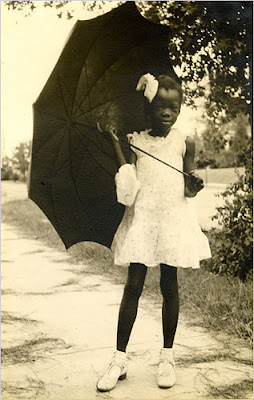
The photography of Eudora Welty is on view in a new exhibit, "Exposures and Reflections," at the Atlanta History Center now through May 8. Welty was a photographer before she was a writer; in 1936, after she learned that a magazine was going to publish two of her short stories, she was overjoyed. "I wanted acceptance and publication," she said later. "If they had paid me a million dollars it wouldn't have made any difference."
Many of her photographs of 1930s Mississippi feature African-Americans, who up to then were "socially invisible" in American society. Welty shows them on the street, window shopping, working, in family groups. T.A. Frail in The Smithsonian magazine of April 2009 notes that although Welty grew up in Jackson, Mississippi, she graduated from the University of Wisconsin and studied business at Columbia University in New York, which helped "move her beyond the confines of her family environment."
She returned to Jackson after her father was diagnosed with leukemia, and began taking photography more seriously in a succession of writing jobs. In a 1989 interview excerpted here, Welty claims no larger agenda for her photographs other than her own, personal one. "I was taking photographs of human beings because they were real life and they were there in front of me and that was the reality," she said.

"Fairgrounds"
"While I was very well positioned for taking these pictures, I was rather oddly equipped for doing it," she would later write. "I came from a stable, sheltered, relatively happy home that by the time of the Depression and the early death of my father (which happened to us in the same year) had become comfortably enough off by small-town Southern standards." ...
It hardly mattered. Through the early '30s, Welty gathered a body of work remarkable for the photographer's choice of subjects and her ability to put them — or keep them — at ease. That is especially noteworthy given that many of her subjects were African-Americans. "While white people in a Deep South state like Mississippi were surrounded by blacks at the time ... they were socially invisible," the television journalist and author Robert MacNeil, a longtime friend of Welty's, said in an interview during a recent symposium on her work at the Museum of the City of New York. "In a way, these two decades before the civil rights movement began, these photographs of black people give us insight into a personality who saw the humanity of these people before we began officially to recognize them."
"Window Shopping"
Welty, for her part, would acknowledge that she moved "through the scene openly and yet invisibly because I was part of it, born into it, taken for granted," but laid claim only to a personal agenda. "I was taking photographs of human beings because they were real life and they were there in front of me and that was the reality," she said in a 1989 interview. "I was the recorder of it. I wasn't trying to exhort the public"—in contrast, she noted, to Walker Evans and other American documentary photographers of the '30s. (When a collection of her pictures was published as One Time, One Place in 1971, she wrote: "This book is offered, I should explain, not as a social document but as a family album—which is something both less and more, but unadorned.") ...
In addition to "Exposures and Reflections" which opens today at the History Center, the Atlanta area is host to several other notable photography exhbits. The High Museum is displaying works by Henri Cartier-Bresson from Feb 19 to May 29th, and the Booth Museum in Cartersville has announced it has extended its Ansel Adams exhibit through March 13.






No comments:
Post a Comment